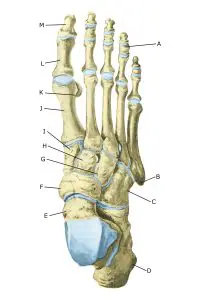Anatomy
The foot below
A. Ossa sesamoidea
B. Talus
C. Calcaneus
Cause
Repeated overstretching of the ankle (plantar flexion) or maximum bending of the ankle (dorsal flexion) can lead to bone damage from collisions or severe stretching of the ligament attachments at the front and back of the ankle joint.
This causes bone formation (spur formation, exostoses), whereby soft tissue from the ligaments and joint capsule can be pinched (impingement) between the bone formations when the foot joint is moved. If the impingement occurs at the front of the ankle joint, it is called anterior footballers ankle, and if the impingement occurs at the back of the ankle joint or subtalar joint, it is called posterior footballers ankle (Dancer’s heel) (K. Lavery, et al. 2019). Approximately 5% have an extra (accessory) bone at the back of the ankle (os trigonum) that can contribute to the pinch, called Os trigonum syndrome. 2% have an os trigonum at the back of both ankles. In some cases, there is a development of a bone prominence on the talus called Stieda process.
Football, volleyball and rugby players, javelin throwers, gymnasts, dancers and athletes who do a lot of push-offs are at greater risk of football ankles. Previous ligament injuries in the ankle joint also increase the risk due to scar tissue formation, which is more easily trapped between the bone formations.
Symptoms
Pain at the front or back of the ankle joint, especially when bending and stretching to the outer position (plantar and dorsal flexion), as when kicking a ball and pushing off (posterior). Even everyday movement (climbing stairs) can provoke pain. There may be swelling after physical activity. Some experience a “clicking” sensation with plantar and dorsal flexion of the ankle.
Examination
The diagnosis can usually be made by clinical examination alone, where there is characteristic tenderness on movement and pressure on the front or back of the ankle joint. X-rays and ultrasound scans may be necessary, while MRI and CT scans are rarely necessary. With ultrasound, it is possible to see minor bone changes, swelling and inflammation of the pinched soft tissue.
Treatment
Treatment primarily includes relief from pain-inducing activity and training to increase mobility in the ankle joint. In the case of an ankle sprain, heel inserts/heel elevation can provide relief. If the pain does not subside despite relief and rehabilitation, medical treatment can be supplemented with arthritis pills (NSAIDs) or ultrasound-guided injection of adrenal cortex hormone around the sore soft tissue. Approximately 75% will be symptom-free within 3-6 months.
If there is persistent pain that does not subside despite relief and medical treatment, additional examinations including binocular examination (arthroscopy) and surgery may be indicated, where bone formation (and possibly os trigonum or stieda) and pinched tissue are removed (NSB Mansur. Et al. 2024 , X Chin, et al. 2023).
Complications
If the progress is not smooth, you should consider whether the diagnosis is correct or if there are complications:
Bone fracture Tendonitis Cartilage damage-osteoarthritis
Fluid in the ankle
External ankle ligament injuries
Internal ankle ligament injuries

